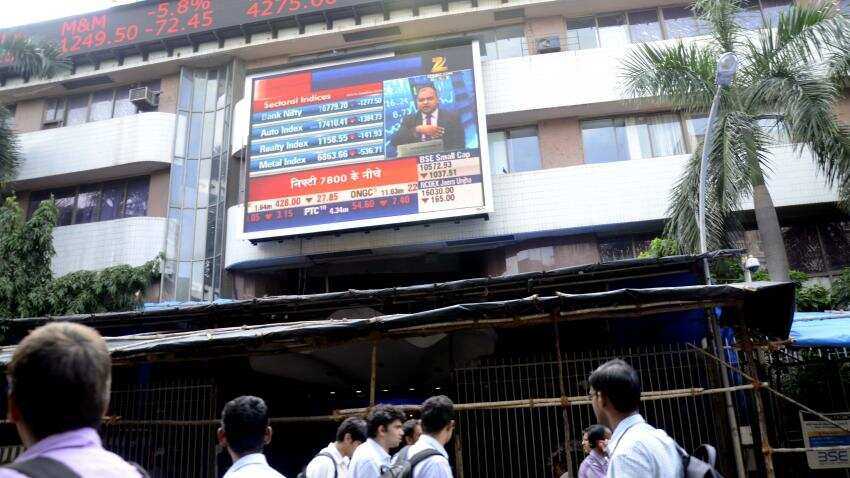Two years of Modi government: What has gone down in stock markets?
It's easy to draw pitch-forks at the Prime Minister but would it be fair to blame Modi alone for what's gone down in the markets?

The Indian stock market saw a huge jump when Narendra Modi was appointed as the prime ministerial candidate in late 2013. Since he took the office two years ago, more than 150 stocks out of the 779 counters of BSE S&P Mid-cap, Small-Cap and BSE-500, have generated more than 100% returns. The BSE even reached 27,600 level when his government completed one year in office on May 2015.
Now in 2016 though, the euphoria on the Dalal Street has ended and the BSE has gone back to the level where it was in 2014. The benchmark BSE Sensex has gained marginally around 4% and it closed at 25,881.17 on May 25, 2016 against 24,716.88 on May 26, 2014.
It's easy to draw pitch-forks at the Prime Minister but would it be fair to blame Modi alone for what's gone down in the markets? No; let us understand what's going on, and the way forward.
What are the reasons behind sluggish growth in the stock market?
Though India continues to remain one of the fastest growing economies in the world, the markets have been under pressure largely because of the following reasons:
1. Global meltdown
2. Failure to roll out GST Bill
3. Low commodity prices
4. Weak private sector participation
5. Stretched balance sheets of banks
6. Tepid growth of factory output
We have seen the rupee nearing its all-time lows and then there are other external factors like the freefalling crude prices and the slowdown in China which is beyond Modi's control. Factors like China's yuan devaluation or the US interest rate hike have only added to the disturbance in the markets in the period.
In the last two years, there has been a slowdown in the global economy with frequent downward revisions of growth forecasts seen across the globe.
While the US markets have still managed to deliver better corporate earnings compared to the emerging markets, it's because the latter is largely affected by the crash in the commodity market.
When we look at our economy, even the stress on the balance sheets of banks due to mounting bad loans and a serious paucity of capital have created a havoc.
Then there's the GST Bill which has been held up because the government doesn't have enough representation in the Rajya Sabha to pass it. A consensus with Congress is still not a part of the picture, and it seems like the government may miss the next deadline too.
One of the areas where you may point fingers at the government or even Modi, is that even as a third term begins, there have been no game-changing reforms, which is a huge cause of worry for the investors.
Another, is that two of the flagship projects ‘Make in India’ and ‘Start-up India” are yet to make any significant progress because foreign direct investment norms haven't been eased in line with expectations of the industry.
What is the way forward?
If you look at the other side of the coin, in the fiscal year-ended on March 31, 2016, our gross domestic product has risen by 7.6%, which has helped us overtake China (in percentage terms) to become the fastest growing economy in the world. Inflation is also nearly half of what it was couple of years ago apart from the fact that India’s budget deficit has reduced to 3.9% of GDP, and FDI and foreign exchange reserves are set to reach new peaks.
The windfall gains from low oil prices has also helped the government manage its import bill and inflation.
Massive projects in roads and railways sectors are in the pipeline and the government is focussed on reviving rural demand to take away the distress caused by two back-to-back poor monsoons.
When initiatives like 'Make in India' and 'Digital India' bear fruits, and a strong push for national highways will give a huge boost to the economy. While that may take time, it's important that the government doesn't let it fade away. The results of these schemes may be visible in the next 1.5 to two years or rather in the next Lok Sabha election in April-May 2019/
My advice to all the investors? Stick to your guns and remain invested in the market. Rather, I'd suggest, put more money gradually in the next few years and be a part of India’s growth story. Stay smart, invest smart.
Rishabh Parakh is a Chartered Accountant and the Chief Gardener & Founder Director of Money Plant Consulting, a leading Tax & Investment Planning Advisory Service Provider. He also runs a personal finance blog called “Mango Investor” aka AAM Niveshak at www.mangoinvestor.com. Readers are invited to send their feedback to [email protected].
12:45 PM IST






 Full Text: What PM Modi said when India signed historic Chabahar port agreement with Iran
Full Text: What PM Modi said when India signed historic Chabahar port agreement with Iran Modi in Iran: It would be a shame for India to miss all the action
Modi in Iran: It would be a shame for India to miss all the action Sensex closes down 71 points after volatile trade
Sensex closes down 71 points after volatile trade Key Indian equity indices open on flat note
Key Indian equity indices open on flat note Indian markets open negative; Sensex down 148 points
Indian markets open negative; Sensex down 148 points